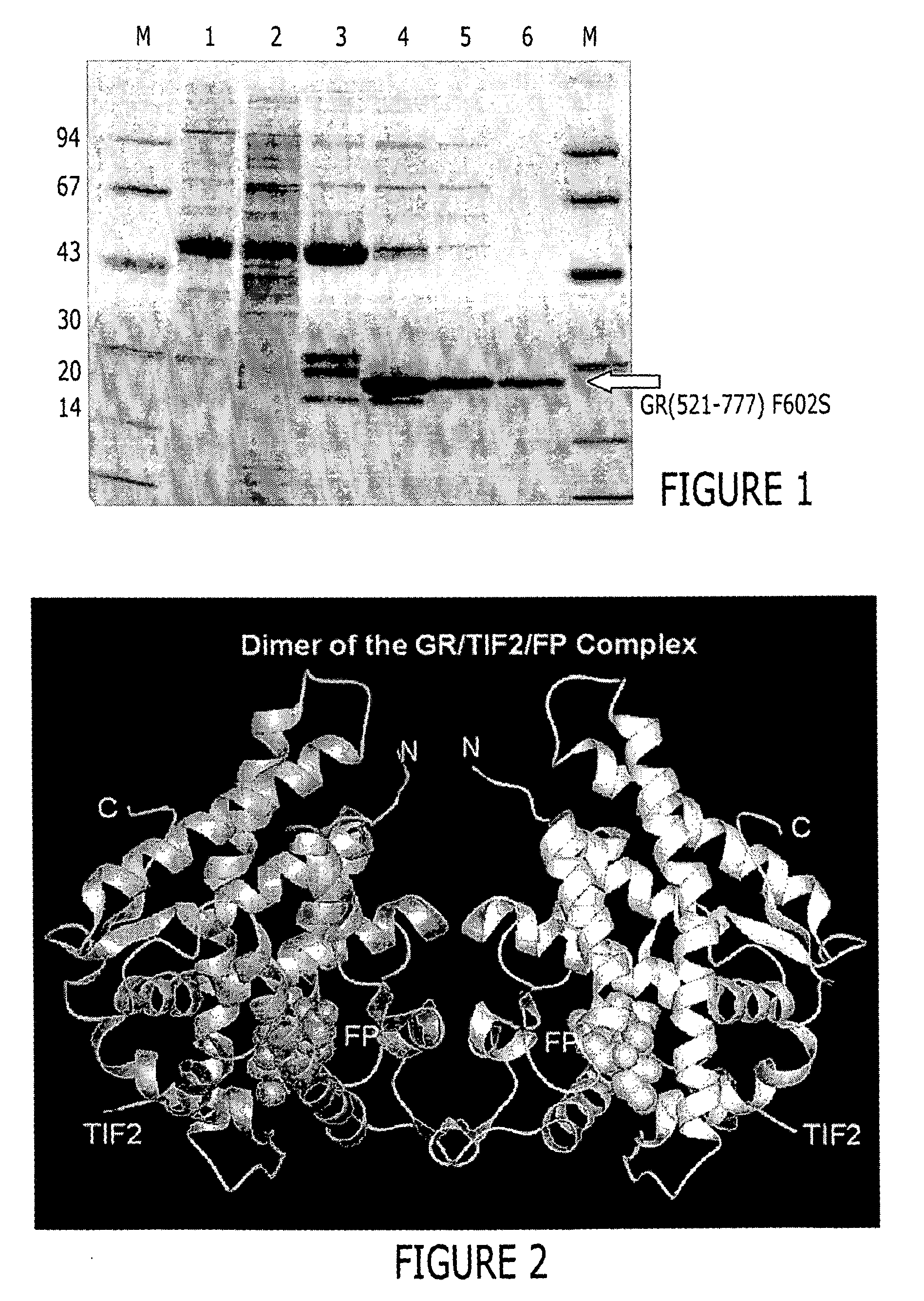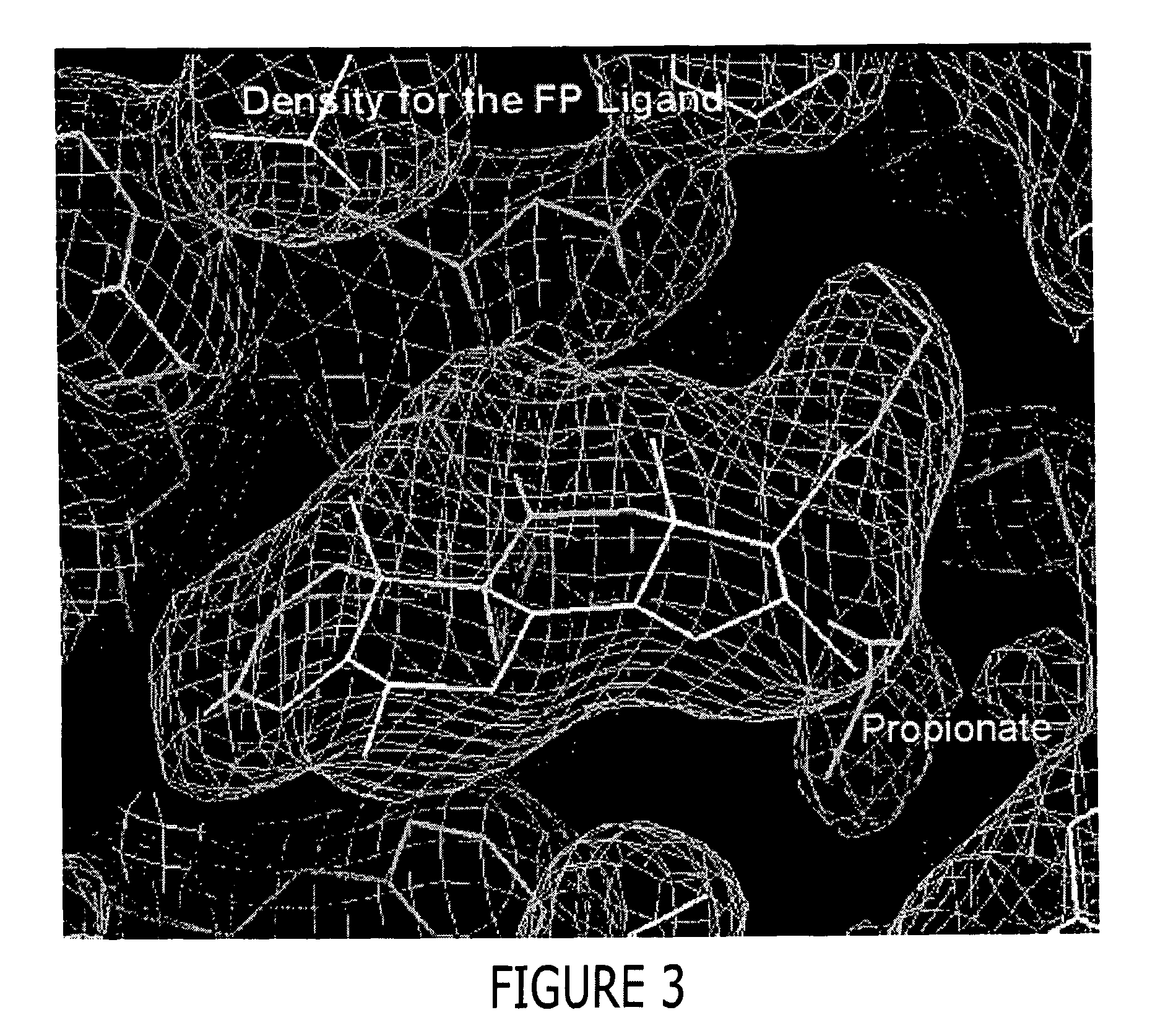Structure of a glucocorticoid receptor ligand binding domain comprising an expanded binding pocket and methods employing same
a glucocorticoid receptor and ligand binding technology, applied in the field of glucocorticoid receptor polypeptides, can solve the problems of inability to use crystals in the ligand binding domain of human glucocorticoid, inability to accurately represent the structure of x-rays, and models that have some utility
- Summary
- Abstract
- Description
- Claims
- Application Information
AI Technical Summary
Benefits of technology
Problems solved by technology
Method used
Image
Examples
example 1
Laboratory Example 1
Expression of a GRα Polypeptide
[0450] BL21(DE3) cells (Novagen / Invitrogen, Inc., Carlsbad, Calif., United States of America) were transformed with the expression plasmid 6xHisGS-TGR(521-777) F602S pET24 following established protocols. Following overnight incubation at 37° C. a single colony was used to inoculate a 10 ml LB culture containing 50 μg / ml kanamycin (Sigma, St. Louis, Missouri, United States of America). The culture was grown for ˜8 hrs at 30° C. and then a 500 μl aliquot was used to inoculate flasks containing 1 liter CIRCLE GROW™ media (Bio 101, Inc., Vista, Calif., United States of America) and the required antibiotic. The cells were then grown at 22° C. to an OD600 between 2 and 3 and then cooled to 18° C. Following a 30 min equilibration at that temperature, dexamethasone (Spectrum Chemical Co., Gardena, Calif., United States of America) (50 or 100 μM final concentration) was added. Induction of expression was achieved by adding IPTG (BACHEM, Ph...
example 2
Laboratory Example 2
Purification of a GR LBD (521-777) F602S Polypeptide Bound to Fluticasone Propionate
[0452] Approximately 37 g of cells were resuspended in 500 mL lysis buffer (50 mM Tris pH=8.0, 150 mM NaCl, 2M urea, and 30 μM fluticasone propionate) and lysed by passing 3 times through a Rannie APV Lab 2000 homogenizer (Rannie APV, Copenhagen, Denmark). The lysate was subjected to centrifugation (30 minutes, 20,000 g, 4° C.). The cleared supernatant was filtered through coarse pre-filters and 50 mM Tris, pH=8.0, containing 150 mM NaCl and 1M imidazole was added to obtain a final imidazole concentration of 50 mM. This lysate was loaded onto a XK-26 column (Pharmacia, Peapack, N.J.) packed with Sepharose [Ni2+ charged] chelation resin (Pharmacia, Peapack, N.J.) and pre-equilibrated with lysis buffer supplemented with 50 mM imidazole. Following loading, the column was washed to baseline absorbance with equilibration buffer. This was followed by a linear (0 to 10%) glycerol and (2...
example 3
Laboratory Example 3
Preparation of a GR / TIF2 / Fluticasone Proprionate (FP) Complex
[0454] The GR / TIF2 / FP complex was prepared by adding a 1.2-fold excess of a TIF2 peptide containing sequence of KENALLRYLLDKDD (SEQ ID NO: 9) during the buffer exchange step as described below. The above complex was concentrated then diluted 1:1 with a buffer containing 500 mM NH4OAC, 50 mMTris, pH 8.0, 10% glycerol, 10 mM dithiothreitol (DTT), 0.5mM EDTA and 0.05% β-octyl-glucoside and concentrated to 1 ml. The complex was diluted 1:9 with the above buffer and slowly concentrated to 7.5 mg / ml in the presence of an additional 1.2 fold excess of a TIF2 peptide (residues 740-753), aliquoted and stored at −80° C.
PUM
| Property | Measurement | Unit |
|---|---|---|
| Fraction | aaaaa | aaaaa |
| Fraction | aaaaa | aaaaa |
| Fraction | aaaaa | aaaaa |
Abstract
Description
Claims
Application Information
 Login to View More
Login to View More - R&D
- Intellectual Property
- Life Sciences
- Materials
- Tech Scout
- Unparalleled Data Quality
- Higher Quality Content
- 60% Fewer Hallucinations
Browse by: Latest US Patents, China's latest patents, Technical Efficacy Thesaurus, Application Domain, Technology Topic, Popular Technical Reports.
© 2025 PatSnap. All rights reserved.Legal|Privacy policy|Modern Slavery Act Transparency Statement|Sitemap|About US| Contact US: help@patsnap.com



